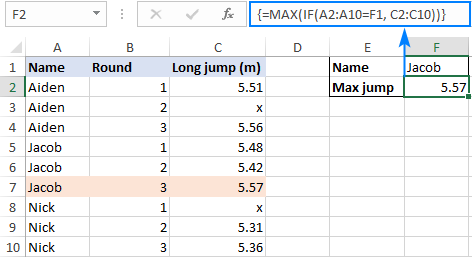

- EXCEL 2013 FOR MAC FORMULA LIST HOW TO
- EXCEL 2013 FOR MAC FORMULA LIST UPDATE
- EXCEL 2013 FOR MAC FORMULA LIST MANUAL
The following list defines the options available in the Calculation options section:
EXCEL 2013 FOR MAC FORMULA LIST MANUAL
Scroll down to the Calculation options section and select Manual to prevent the formulas from being calculated every time you make a change to a value, formula, or name or open a worksheet containing formulas. On the Excel Options dialog box, click Formulas in the menu on the left. See many other neat things to learn on your site.Click the Options item in the menu on the left. Sounds simple once you know it, but nowhere findable in the Microsoft documentation 🙂
EXCEL 2013 FOR MAC FORMULA LIST HOW TO
Today after more googling I learned how to add a text box to a chart in Microsoft Excel for Mac 2011, and with some effort I was able to fill that text box with the contents of TODAY() in a date-formatted cell on a worksheet, then move the text box just behind the chart title so that it looked as if it were one field.īut that seemed very klutzy and fortunately I found a better way – it turns out that I needed to concatenate my text in one cell with today’s date in a different cell while converting the date to text.įor example if the desired chart title’s text is in R3 and today’s date is in S2, then the concatenated cell to use as the chart title would be set to: Excel kept changing the format back to general. I had tried formatting my target cell as date but Excel rejected that because I had text as well as an & and the today function in the one cell. Many thanks for your email and your suggestion. If I type 2 into cell A1, then type =A1 into cell A2, then A2 refers back to A1 and gives a result of 2. This example is intentional, and the result of the formula is zero. The consequence would be a warning from Excel if you did not create this circular reference intentionally. If I type =A4+1 in cell A4, I directly refer to the cell containing the formula. A circular formula refers back to itself either directly or indirectly. You may have come across them before, but if not, here’s a quick rundown. Of course, you can, but it takes a bit of Excel magic and an understanding of Circular Formulas. That’s all well and good, but wouldn’t it be great to insert your changes to a worksheet and the timestamp appear as you type?.

However, they are both very manual, inserting the date or date and time with the keyboard to insert the Excel timestamp. These both will remain static, unlike the volatile formulas. Therefore, the following shortcuts could be an alternative.ĬTRL+ to enter the current date or CTRL+SHIFT+: to insert the current time
EXCEL 2013 FOR MAC FORMULA LIST UPDATE
For example, an invoice update or a sign in from a user. The whole point of the Excel timestamp is to be static once updated. This recalculation is not any good for a timestamp.
:max_bytes(150000):strip_icc()/ExcelDropDownList2-4a4bbc1bfe954aeeb77523293cf07514.jpg)
Known as “volatile" functions, they recalculate every time the Excel workbook is updated. These update automatically when Excel updates. We probably all know that we can use the =TODAY() or the =NOW() formula to enter a date into Excel. Use TODAY and NOW Functions To Insert An Excel Timestamp. However, entering this data is usually done manually by the user and takes way too much time for us to Excel At Excel. So, under lots of circumstances, would you enter the date on a spreadsheet for an entry onto an invoice, a project plan, etc., and you would do this by entering the current date and time.


 0 kommentar(er)
0 kommentar(er)
